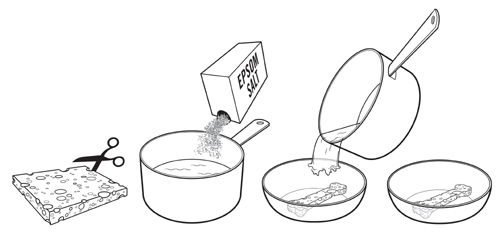Does It Take Millions of Years for Fossils to Form?
How long does it take fossils to form? Did fossils form over millions of years as dead plants and animals were buried and then turned into rock? We can get answers from the Bible!
The Bible tells us that there was a global Flood around 4,000 years ago (Genesis 6–9). Genesis 7:19–20 states that the Flood covered all the mountains, and all the land was under water:
And the waters prevailed exceedingly on the earth, and all the high hills under the whole heaven were covered. The waters prevailed fifteen cubits upward, and the mountains were covered.
A worldwide Flood would be way more destructive than any floods we observe today.
Evolutionists often wrongly use rocks and fossils to support long ages of evolutionary change, but since Noah’s Flood really occurred, it must have laid down the rock layers and fossils. Take rocks and fossils away from evolutionists and evolution’s story, and they have no evidence remaining!Don’t think of the Flood as a time when things were merely carried along and then settled out of moving water. Rather, the sediments were deposited . . . one following the other until thick sequences of layers had accumulated . . . The whole sediment package amassed quickly, within the Flood year, not over the hundreds of millions of years claimed by evolutionists.1
Mount St. Helens erupted in 1980 with the force of 1,600 atomic bombs.2 Huge mudflows and water waves changed the landscape. Nearly 20,000 logs wound up “standing” in the lake, “rooted” through layers of sediment. If all the water was drained out of Spirit Lake, the upright logs might look a little like a forest!3
The upright logs in Spirit Lake look like the petrified forests found buried in rock layers at Yellowstone Park. Petrified wood is formed when some of the materials in the wood are replaced by minerals and turned into rock. Yellowstone Park is an area with past volcanic activity, which could provide the right conditions for petrification.
The thousands of upright logs in Spirit Lake show us how the petrified logs in Yellowstone Park may have formed.4
The Bible helps us to understand that it didn’t take millions of years for fossils to form. In fact, the Bible tells us that the earth is only around 6,000 years old. Would you like to create your own fossils? Ask an adult to help you do this experiment.
You will need to understand the difference between petrification and permineralization to answer the questions at the end of this experiment. In permineralization, minerals fill in tiny holes in the material—some so small you can’t even see them without a microscope. Petrification is when the material itself—not just the spaces in between—is replaced by minerals.
See For Yourself . . .
Fossils are rare today, but you can make them in your own home! Try the following experiment and watch a kitchen sponge “fossilize!”
Materials
- 2 kitchen sponges
- 1 shallow dish
- 1 small pot
- 1 cup of water
- Epsom salt
- Food coloring

Procedure
(Adults should supervise the experiment and perform all cutting.)
- Cut both sponges into bone shapes and set one aside. Place the other sponge into a shallow dish.
- Heat water close to boiling and stir in as much Epsom salt as will dissolve. Add food coloring to water (if desired).
- Pour the salt water over the sponge.
- Place the bowl where it will not be disturbed for a few days. Leave uncovered so the water can evaporate.
Final Result
Once dry, compare the two sponges. Break the fossil in half. What happened to the sponge material? Was it encased (permineralized) or replaced (petrified)?
[Editor’s Note: Adapted from an article by Heather Brinson Bruce, “Experiment: Fast-Formed Fossils,” Answers, October–December 2011.]
Footnotes
- John Morris, “Do Fossils Show Signs of Rapid Burial?,” The New Answers Book 3, https://www.answersingenesis.org/fossils/how-are-fossils-formed/do-fossils-show-signs-of-rapid-burial/.
- Steve Austin, “Why is Mount St. Helens Important to the Origins Controversy?,” The New Answers Book 3, https://www.answersingenesis.org/geology/mount-st-helens/why-is-mount-st-helens-important-to-the-origins-controversy/.
- Ibid.
- Ibid.
Recommended Resources
- © 2024 Answers in Genesis
- Privacy Policy
- Contact
- About



